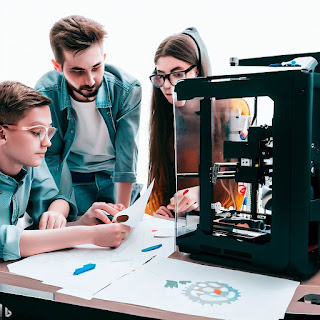3D printing is a rapidly growing technology that is having a major impact on the manufacturing industry. It is also becoming increasingly popular in education, as it offers a unique way to teach students about science, technology, engineering, art, and mathematics (STEAM).
In this blog post, we will explore how 3D printing can be used to teach STEAM concepts. We will also discuss the benefits of using 3D printing in education and the challenges that need to be addressed.
3D printing and STEAM
3D printing is a process of creating three-dimensional objects from a digital file. The object is created by depositing layers of material, such as plastic or metal, onto a build platform. The object is then finished by removing any excess material.
3D printing can be used to create a wide variety of objects, from toys and jewelry to medical devices and prototypes. It is also a great way to teach STEAM concepts.
Here are some specific examples of how 3D printing can be used to teach STEAM concepts:
- Science: 3D printing can be used to teach students about the properties of different materials, such as their strength, flexibility, and conductivity. Students can also use 3D printers to create models of scientific phenomena, such as the solar system or the human body.
- Technology: 3D printing can be used to teach students about the basics of computer-aided design (CAD) software and how to use it to create 3D models. Students can also use 3D printers to create their own custom designs.
- Engineering: 3D printing can be used to teach students about the principles of engineering, such as stress, strain, and structural analysis. Students can also use 3D printers to create prototypes of their designs and test them out.
- Art: 3D printing can be used to create a wide variety of artistic objects, such as sculptures, jewelry, and furniture. Students can also use 3D printers to create their own custom designs.
- Mathematics: 3D printing can be used to teach students about the concepts of geometry, trigonometry, and calculus. Students can also use 3D printers to create models of mathematical objects, such as fractals and 3D shapes.
Benefits of using 3D printing in education
There are many benefits to using 3D printing in education. Some of the benefits include:
- Engagement: 3D printing is a hands-on activity that can help students learn more effectively. It can also help students to develop problem-solving skills and creativity.
- Real-world relevance: 3D printing is a real-world technology that is used in a wide variety of industries. This makes it a valuable tool for teaching students about the latest technologies and how they can be used to solve problems.
- Customization: 3D printing allows students to create custom objects that meet their specific needs. This can help students to develop their own unique ideas and solutions.
- Accessibility: 3D printing is a versatile technology that can be used to create objects for a wide range of students, regardless of their abilities. This makes it a valuable tool for inclusive education.
Challenges of using 3D printing in education
While there are many benefits to using 3D printing in education, there are also some challenges that need to be addressed. Some of the challenges include:
- Cost: 3D printers can be expensive, which can make it difficult for schools to afford them.
- Training: Teachers need to be trained on how to use 3D printers and how to integrate them into their lesson plans.
- Safety: 3D printers use heat and lasers, which can pose a safety hazard if not used properly.
- Materials: 3D printers require specific materials to work, which can be expensive.
Conclusion
3D printing is a powerful technology that has the potential to revolutionize education. Despite some challenges, 3D printing can be a valuable tool for teaching STEAM concepts and helping students to learn more effectively.
If you are interested in using 3D printing in your classroom, there are a number of resources available to help you get started. The website of the 3D Printing Education Coalition is a great place to start.
Thank You
Visit us:M S Innovations


Comments
Post a Comment